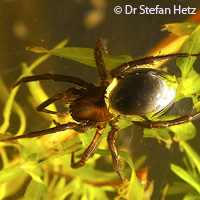How water spiders breathe below the surface
Diving bell spiders may have no gills but they have successfully found a niche under water, calling that environment home. But researchers never knew the length of time these spiders could remain submerged before replenishing their diving bell air supply. A German-Australian team of researchers, however, sheds new light on how these spiders, the Argyroneta aquatica, venture above the surface to take in much-needed oxygen. Presented in the Journal of Experimental Biology, the German and Australian researchers measured the bubble's oxygen level, discovering that the diving bell acts like a gill sucking oxygen from the water. So these spiders just have to make a very fast trip to the surface once a day to get oxygen. 'It is an iconic animal,' says Professor Roger Seymour of the University of Adelaide in Australia, 'I had read about the spider as a small boy in popular literature about ponds.' Professor Seymour, in collaboration with Dr Stefan Hetz from Humboldt University of Berlin in Germany, investigated this spider which builds a net of silk in vegetation at the surface and fills it with air carried down on its abdomen. The diving bell spiders always live under water and even lay their eggs in their diving bells. Having already used an optode, a device to measure oxygen, to determine how aquatic insects extract oxygen from water through thin air bubbles stretched across their abdomens, Professor Seymour sought to test his optode on other small bubbles. 'The famous water spider came to mind,' explains Professor Seymour. For his part, Dr Hetz invited his Australian colleague to work at the Humboldt laboratory and determine how these unique spiders use their diving bells. The duo obtained a permit to collect diving bell spiders from the Eider River in the German state of Schleswig-Holstein. It should be noted, however, that diving bell spiders are becoming increasingly rare in Europe. 'My philosophy is to make some measurements and be amazed because if you observe nature it tells you much more than you could have imagined,' Professor Seymour says, adding that the researchers reproduced the conditions in a laboratory, creating a warm yet stagnant pond with weeds on a hot summer day. The objective here was to discover how these spiders manage to survive in the most challenging conditions. The researchers poked an oxygen-sensing optode into the spider's newly produced air bubble to see its reaction. According to the researchers, the spider remained calm, allowing them to measure its oxygen level. 'Then it occurred to me that we could use the bubble as a respirometer' to determine the amount of oxygen consumed by the spider, Professor Seymour points out. After measuring the oxygen in both the bubble and surrounding water, the researchers calculated the amount of oxygen flowing into the bubble before measuring the spider's oxygen consumption rate. They discovered that the diving bell could extract oxygen from the most stagnant water despite how hot the day was. They also found that the spider's metabolic rate was low, liking it to the low metabolic rates of other spiders that bide their time waiting for prey to pass. They found, however, that because nitrogen diffuses back into the water, the bubble shrinks and forces the spider to make its way to the surface and resupply the diving bell. After measuring the diffusion rate of nitrogen out of the bubble, the duo found that the spiders could stay beneath the surface for more than 24 hours. 'The previous literature suggested they had to come to the surface as often as every 20-40 minutes throughout the day,' says Professor Seymour, 'It is advantageous for the spiders to stay still for so long without having to go to the surface to renew the bubble, not only to protect themselves from predation but also so they don't alert potential prey that come near.'For more information, please visit:Journal of Experimental Biology:http://jeb.biologists.org/Humboldt University of Berlin:http://www.hu-berlin.de/standardseite-en
Countries
Australia, Germany



